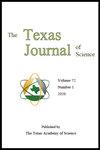POST-PLEISTOCENE HORSES (EQUUS) FROM MÉXICO
Q4 Agricultural and Biological Sciences
引用次数: 0
Abstract
For more than a century many paleontologists, biologists, paleoecologists, and archaeologists have contended that Equus species (American horse) became extinct on the North American continent by about 13,000 calibrated years BP – all part of the Late Pleistocene (Ice Age) extinction event. The paleontological project presented here that focuses on Equus from Rancho Carabanchel, San Luis Potosí, México became chronologically intriguing to us in having the horse consistently radiometrically dating into the Holocene, well beyond the presumed extinction event. Our approach to this observation was to conduct successive radiocarbon dates (n=19) tied as closely as possible to fossil remains and to stratigraphic units. The remains of the extant horse, Equus caballus, were recovered only in the upper-most Unit I while the extinct Equus cf. mexicanus, E. cf. conversidens, and E. cf. tau were recovered from the underlying Units II – VI of the late Holocene to approximately 45,000 calibrated years ago. We discuss how our data adds to the growing information which implies that horses may have persisted in this region of México well after the classical Late Pleistocene extinction event. Our conclusions may well illustrate that the extinction episode was actually a process lasting well into the Holocene and was not the event that many paleoecologists and archaeologist envision.后更新世马(马属)来自mÉxico
一个多世纪以来,许多古生物学家、生物学家、古生态学家和考古学家一直认为,美洲马在北美大陆灭绝了大约13000年,这都是更新世晚期(冰河时代)灭绝事件的一部分。这里介绍的古生物学项目专注于墨西哥圣路易斯波托西Rancho Carabanchel的Equus,从时间上讲,这匹马的放射性年代一直持续到全新世,远远超过了假定的灭绝事件,这对我们来说很有吸引力。我们的观测方法是进行连续的放射性碳年代测定(n=19),尽可能与化石遗迹和地层单位密切相关。现存马的遗骸,Equus caballus,仅在最上层的单元I中被发现,而已灭绝的Equus cf.mexicanus、E.cf.conversidens和E.cf.tau,则在全新世晚期至约45000年前的底层单元II–VI中被发现。我们讨论了我们的数据如何增加不断增长的信息,这意味着马可能在典型的晚更新世灭绝事件之后很久就一直存在于墨西哥的这一地区。我们的结论很可能说明,灭绝事件实际上是一个持续到全新世的过程,而不是许多古生态学家和考古学家所设想的事件。
本文章由计算机程序翻译,如有差异,请以英文原文为准。
求助全文
约1分钟内获得全文
求助全文
来源期刊

The Texas Journal of Science
Agricultural and Biological Sciences-Ecology, Evolution, Behavior and Systematics
CiteScore
0.50
自引率
0.00%
发文量
2
期刊介绍:
Scholarly manuscripts reporting original research results in any field of science or technology, including science education, will be considered for publication in The Texas Journal of Science. Prior to acceptance, each manuscript will be reviewed by both knowledgeable peers and the editorial staff. Authors are encouraged to suggest the names and addresses of two potential reviewers to the Manuscript Editor at the time of submission of their manuscript.
 求助内容:
求助内容: 应助结果提醒方式:
应助结果提醒方式:


